Chapter 10: Millet Breeding
Teshale Mamo; Asheesh Singh; Anthony A. Mahama; and Walter Suza
Millets are tall and vigorous grasses with panicles containing small seeds, and are grouped in the cereal family Gramineae, same category as sorghum and maize. Millets are adapted and used as staple food in the semi-arid tropics of Africa and Asia where other crops generally cannot be grown. Pearl millet (Pennisetum glaucum L.), finger millet (Eleusine coracana L.), foxtail millet (Setaria italic L.) and proso millet (panicum miliaceum) are among the millet species grown widely in Africa, Asia, Europe and North America.
- Become familiar with the Millet crop
- List breeding institutions working on this crop
- Know crop biology and classification system
- Describe adaptation and usage
- Outline production constraints
- Discuss breeding method used to develop pearl millet cultivars
Origin and Domestication
History
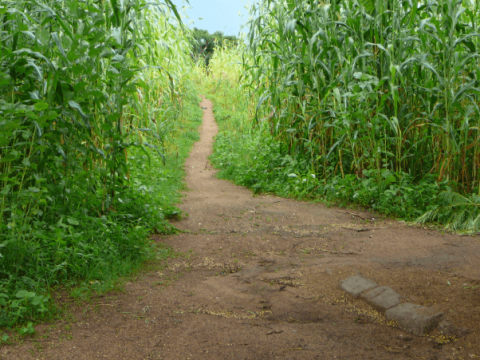
Millet is one of the ancient staple human foods and believed to be the primary domesticated cereal crop. Although the exact origin and domestication of millet remains unclear, it is believed that millet was domesticated and cultivated over 7000 years ago during the Neolithic era in Africa and then distributed throughout the world as human food. To date, a total of 161,708 accessions of millet species have been collected and preserved in gene banks across the globe, and these collections comprise 98.1% of cultivated types (Sangham et al., 2012). Fig. 1 shows a field of millet with a path through it, in the Upper Region of Ghana, which is characterized by generally sandy soils and limited rainfall regimes.
Global Production
Globally, millets are grown in over 90 countries from 2004 to 2008 and on average contribute 32.3 million tons of food production annually (http://faostat.fao.org/). Major producers of millet include India, China, Nepal, Pakistan, and Myanmar in Asia, and Nigeria, Niger, Senegal, Cameroon, Burkina Faso, Mali, Uganda, Kenya, Namibia, Tanzania, Togo, Senegal, Chad and Zimbabwe in Sub-Saharan Africa (Sangham et al., 2012). Pearl millet is mainly grown in South Asia and Sub-Saharan Africa while Finger millet is grown mainly in South and Southeast Asia and East Africa. Foxtail millet is grown mainly in South and Southeast Asia, while Proso millet is grown mainly in Asia, Europe, and North America.
Finger millet, foxtail millet, Pear millet, and Proso millet are the largest collection of cultivated millet germplasm. The International Crops Research Institute for the Semi-Arid Tropics (ICRISAT) is one of the Consultative Group on International Agricultural Research (CGIAR) centers that has a mandate to work on millet, and ICRISAT coordinates all millets research programs in the semi-arid tropics. A large number of millet germplasm is preserved in the ICRISAT gene bank in Patancheru, India. In addition, East African countries (Ethiopia and Kenya), and West African countries (Nigeria and Senegal) preserved significant numbers of millets in their gene banks. In the USA different species of millet are also preserved in gene banks based in Fort Collins, Colorado; Griffin, Georgia; Ames, Iowa; and Pullman, Washington.
Morphology
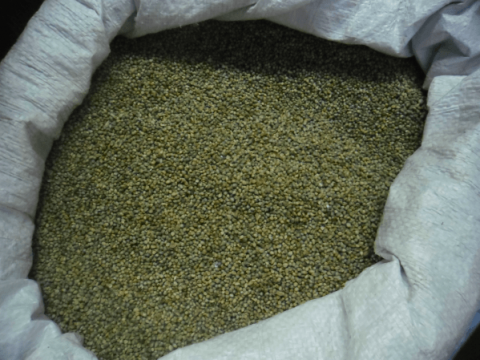
Pearl millet (Pennisetum glaucum), commonly known as bulrush millet, is a member of the grass family and originated in the semi dry land tropics of western Africa. The diversity and current distribution of the crop indicate that a large number of cultivated and wild forms of pearl millet is found from western Sudan to Senegal. In western Africa, a higher morphological diversity of pearl millet is found particularly in the south of the Sahara desert (Harlan, 1971; Harlan et al., 1975; Tostain et al. 1987). It is believed that the evolution of the crop under the pressures of high temperature and drought made pearl millet tolerant to moisture stress and high temperatures, in addition to low soil fertility. Such tolerance makes pearl millet a very important crop to farmers in the hot dessert parts of Africa and Asia.
Races
Pearl millet is grouped into four races based on grain shape.
- Race typhoides: This race is typically identified by obovate caryopsis in which the cross sections are obtuse and terete. The shape of the inflorescences is cylindrical and has more diverse morphology among the four races. This group occurs widely in all Africa and it is widely grown in India (Brunken et al. 1977).
- Race Nigritarium: the cross-section in caryopsis is angular with three and six facets in each grain. It has candle-like inflorescence and mature grain is longer and protrudes beyond the floral bracts compared to other group of races. Western Sudan and Nigeria are the main places where this race is found.
- Race Globosum: It has spherical caryopsis with candle shape inflorescence. It is mainly found in central Nigeria, Niger, Ghana, Togo and Benin
- Race Leonis: It has an acute and terete caryopsis. The unique character of this race is its acute apex, which is ended by the remnants of the stylar base. It has candle-like inflorescence shape. It is mainly grown in Sierra Leone but also produced in Senegal and Mauritania.
Biology of the Plant
Pearl millet is a warm season grass that uses the high efficiency C4 type of photosynthesis to fix carbon and thus has the ability to produce high dry matter. It is a short day plant requiring long nights before flower initiation. It is produced mainly for grain and forage in the semi-arid tropics of Africa and the Indian subcontinent. The crop grows on different types of soil including, light textured soils, sandy, and on acidic less fertile soils.
In Pearl millet, a wide variation is observed for vegetative, reproductive and physiological features, and these variations are advantageous in the development of cultivars adapted to different climates, environments and cropping systems. Knowledge of pearl millet biology has enabled breeders to develop different cultivars that are adapted to varied environmental conditions (Khairwal et al. 1990).
Growth and Development
Vegetative Phase
Pearl millet has three well defined growth phases: the vegetative phase; reproductive phase; and the grain filling phase.
This phase is from emergence to floral (panicle) initiation of the main stalk. The seed of pearl millet takes 2-3 days to germinate under optimum temperature and moisture. The root has monocotyledonous type of root system consisting of a primary root, and adventurous type roots. It has deep root system penetrating up to 180 cm below the soil surface to absorb water. A research report indicated that in heavy-tillering pearl millet plants, the root system tends to have more horizontal spread than deep penetration. Similarly, those cultivars tolerant to early season moisture stress (3-15 days after sowing) have a 35% more root length than the susceptible cultivars.
Pearl millet is an upright annual grass that tillers from the base. The main stems are 1-2 cm in diameter and are solid, attaining a height of 2-4 m with a round and oval shape. Pearl millet stem has slightly swollen nodes with a ring of adventitious roots at the basal end. Usually the internodal length increases upwards from the base of the stem. Pearl millet leaves appear as single leaf on each node in alternate orientation with leaf sheaths open and hairy ligules. Pearl millet has high potential to produce effective tillers enhancing the probability of producing more seeds from the same plant if flowering of tillers is synchronized with that of the main shoot. Different tillers arise from different branches and all can potentially bear productive panicles, a situation that can be important during unfavorable environmental conditions such as extreme drought.
Reproductive Phase
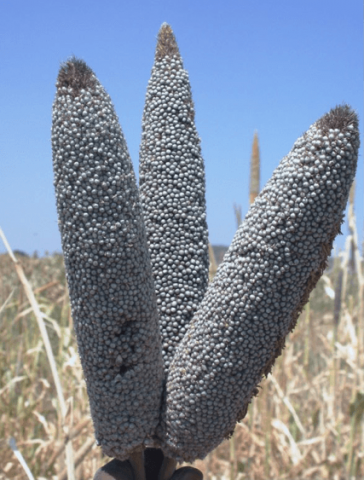
Reproductive stage is started by the formation of a dome-like structure which leads to the development of spikelets, florets, glumes, stigma and anthers, and finally stigma emergence (flowering) and pollination occurs. This is the time that marks the end of the reproductive stage. The critical time for grain number determination in pearl millet is the period between panicle initiation to anthesis. The inflorescence in pearl millets is a compound terminal spike known as panicle and is often similar in size and shape for a particular genotype.
Usually the panicle is compact and cylindrical or conical in shape, 2-3 cm in diameter, and usually 15-45 cm long.
Grain Filling Phase
This is the stage that fertilization taking place in the panicle of the main shoot and continues until the plant matures. During this phase, plant dry weight increases in the grain (seed). However, in some cultivars, elongation and flowering of tillers takes place during this time and in this case there is some dry matter translocation to the non-grain components, mainly to stems of the tillers. The end of physiological maturity or grain filling stage is clearly marked by the development of a dark layer of tissue on the grain. For most cultivars, this dark layer of tissue occurs in an individual panicle 20-25 days after flowering.
Adaptation, Economic Importance and Uses
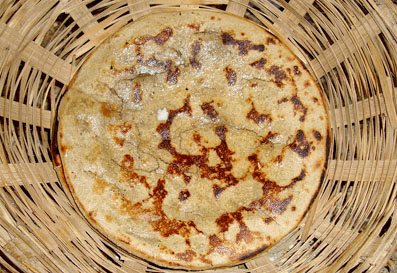
Pearl millet is produced annually on about 29 million ha in the dry land tropical regions of which 16 million hectares are grown in Africa), 11 million hectares in Asia, and 2 million hectares in Latin America (FAO data, 2005). Pearl millet accounts for about half of the world’s millet production. Africa accounts for about 60% of the area under millet cultivation, followed by 35% in Asian countries (primarily India), 4% European countries, and 1% in North America where millet is mainly used as forage and for poultry feed. Pearl millet is the third major cereal crop produced and used as staple food in sub-Saharan Africa which spans Nigeria, Niger, Burkina Faso, Chad, Mali, Mauritania, Senegal, Sudan, and Uganda.
Pearl millet is referred to as subsistence staple food of the poor people living in semi-arid and arid environments in Asia and Africa. Ninety-three percent of pearl millet grain is used as food in developing countries of Africa and Asia while the rest (7%) is used for animal and poultry feed in USA, Australia and South Africa (Sangham et al., 2012). The crop is traditionally used to prepare food products such as flat bread, stiff roti and porridge. It is used for bakery products and snacks.
Soil Types
Pearl millet is grown on wide range of soil types, but light sandy soil is the best suited for the crop with rainfall of 350 to 700 mm per annum. Its high tolerance to drought allows pearl millet to regrow and produce tillers to compensate for losses due to drought stress thereby resulting in faster regeneration of yield of about 4000-5000 kg/ha when conditions are favorable. However, severe drought conditions result in yield reduction in the range between 500 to 600 kg/ha. In marginal areas, pearl millet is more reliable than other cereals such as sorghum and maize. In some parts of the world, pearl millet is produced in warm areas overlapping with other cereals such as sorghum, but it is less tolerant to waterlogging and flooding.
Production Constraints
Biotic stress: Diseases and insect pests are the major biotic factors significantly reducing grain yield and quality in pearl millet. Among bacterial diseases, bacterial spot (caused by Pseudomonas syringae) and bacterial leaf streak (caused by Xanthomonas campestris pv. pennamericanum) are the major causes of yield loss in pearl millet. Fungal diseases including downy mildew (caused by Sclerospora graminicola and Plasmopara penniseti), blast (caused by Pyricularia grisea), smut (caused by Moesziomyces penicillariae or Tolyposporium penicillariae) and rust (caused by Puccinia substriata var. penicillariae) cause more yield loss than other fungal diseases. Among insect pests, millet head miner and stalk borer cause serious problems to pearl millet plants. Parasitic weeds such as Striga hermonthica and Striga asiatica are major plant pests contributing to yield reduction in pearl millet. These two parasitic weeds are serious problems in sub-Saharan African countries. Parasitic nematodes are also major problems in pearl millet production regions.
Abiotic stress: Significant yield losses can result due to abiotic stresses which include drought (in all pearl millet growing regions), high soil salinity and soil acidity, and extreme high temperature at seedling stage and during flowering.
Pearl Millet Breeding
Basics
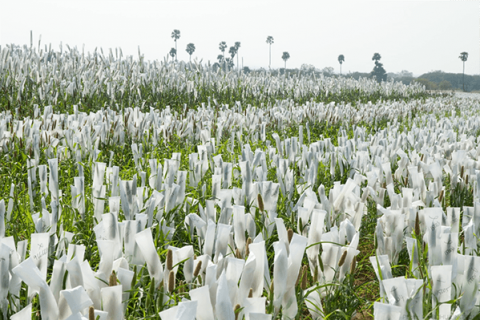
Pearl millet (chromosome number of 2n=2x=14) is a diploid hermaphrodite with a protogynous type of flower development. Protandry (the stigma is receptive before the anthers are ready to shed pollen) in the hermaphroditic flowers of pearl millet enhances a high rate of cross pollination (> 85% outcrossing). Breeding of pearl millet began in Asia, particularly in India, in the early 1930s with an emphasis on high yield production and productivity, while in the USA the focus was on forage and biomass yield production. In West Africa, early breeding for pearl millet started in the 1950s emphasizing increases in grain yield. The discovery of A1 cytoplasmic-nuclear male sterility (CMS) system in Tifton, Georgia, USA and initiation of breeding of a commercially viable male-sterile line (A-line) is a breakthrough for hybrid cultivar development in pearl millet and this led to the release of the first F1 grain hybrid for production in India.
Male Sterility
Cytoplasmic-nuclear male sterility also provides control over outcrossing, enabling the application of testcross method where a large number of inbred lines could be crossed with few, better and high general- and specific-combining ability CMS inbred lines.
Breeding objectives of pearl millet at ICRISAT include:
- high grain yield with compact head, more tillers, earliness and reduced plant height;
- high forage yield with high biomass and good digestibility;
- resistance to diseases, insect pests and striga;
- tolerance to drought, heat and acid soils.
Pearl millet breeding programs employ both hybrid and population improvement approaches at ICRISAT and West Africa and these methods help breeders to develop open pollinated cultivars (mainly in Africa) and hybrid cultivars (India and China).
Breeding Methods
Mass selection: This is the most common type of cultivar development method being used in several African and Asian countries. In this method, a group of pearl millet plants are selected from an open-pollinated population and the seeds from selected plants are mixed and planted to begin the next cycle of selection. Mass selection in pearl millet has helped to improve traits with high heritability. The main criteria that have been taken into consideration to improve grain yield in pearl millet are head characteristics such as compactness, length of ear, the weight of grain, and uniform maturity.
Synthetic cultivar development: Synthetic varieties are developed in open pollinated crops by mixing several hundred elite genetic stocks/germplasm with one or more important traits in common. The synthetic cultivar developed in the first generation or cycle exhibits considerable heterosis.
Hybrid breeding: The hybrid breeding program at ICRISAT and West Africa includes the development of inbred lines and pure line selection and the use of cytoplasmic male sterility. Cytoplasmic male sterility in pearl millet has been used to produce a hybrid for grain production in India and for forage production in the USA. Several sources of male-inducing cytoplasm have been discovered in pearl millet including A1, A2, A3, A4, and A5. A1 is the most commonly used male sterile line for hybrid grain production in India. The CMS system involves the development of three-line systems (A, B, and R) in order to produce hybrid seeds. Line A is male sterile and serves as the seed parent, line B has the recessive form of the fertility restorer gene in the nucleus and does not have the capacity to restore fertility in A system; it maintains sterility. The R line has the dominant form of the fertility restorer genes, and so reverses the effects of the CMS cytoplasm of the A-line, therefore resulting in fertile hybrid seeds when used as a male parent. B and R lines should be multiplied in separate and isolated fields to maintain purity. For details, refer to Crop Improvement modules 5 (Steps in Cultivar Development) and 6 (Breeding Methods).
References
Bruken, J., J.M.J. de Wet, and J.R. Harlan. 1977. The morphology and domestication of pearl millet. Eco. Bot. 31:163-174.
Harlan, J. R. 1971. Agricultural origins: centers and non-centers. Science, 14: 468474.
Harlan, J. R., J. M. J. de Wet, and A. B. L. Stemler. 1975. Plant domestication and indigenous African Agriculture. Pages 1-9. In: Origins of African domestication. (J.R. Harlan, J.M.J. de Wet and A.B.L. Stemler, eds.) Mouton Publishers, The Hague, The Netherlands.
Khairwal, I.S., C. Ram, and A.K. Chhabra. 1990. Pearl Millet Seed Production and Technology. Manohar Publications, New Delhi, India.
Sabgm, D., H. Upadhyaya, S. Senthilvel, and C. Hash. 2012. Millets: Genetic and Genomic resources. Plant Breeding Reviews. Vol 35. Pp 246-374.
Tostain, S., M. F. Raindey, and L. Marchias. 1987. Enzyme diversity in pearl millet (Pennisetum glaucum). 1 West Africa. Theoretical and applied genetics 74:188-193.

